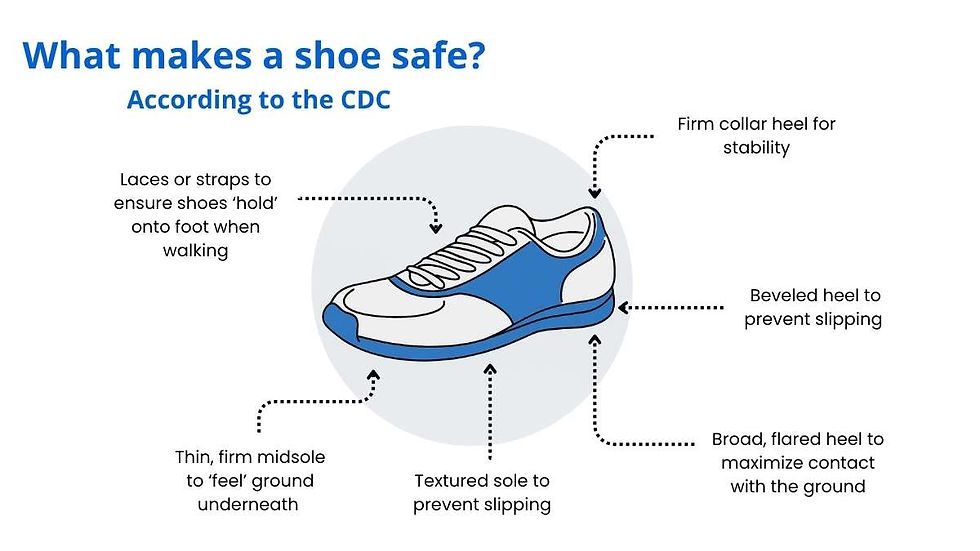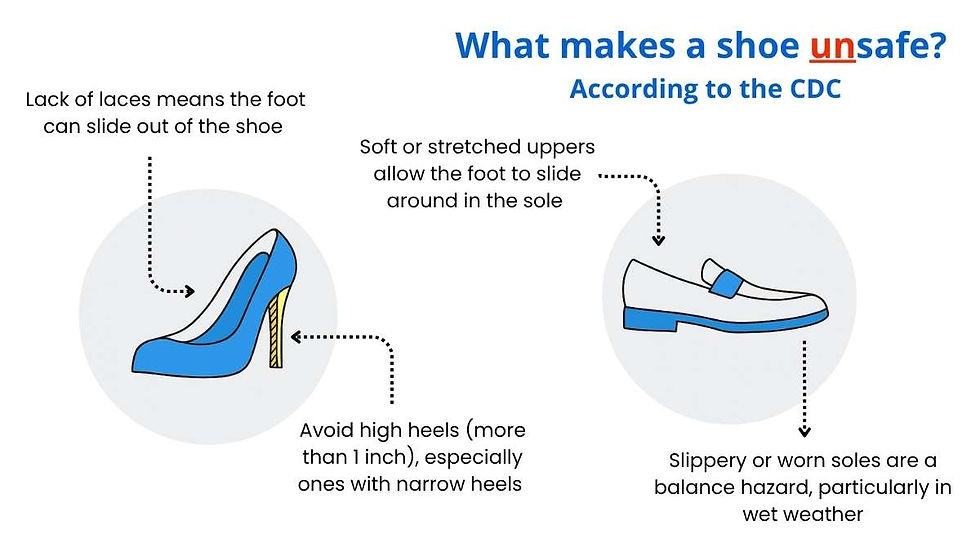The Right Footwear for Fall Prevention
- Elder Love USA
- Aug 11
- 3 min read
Falls are a serious risk for older adults, and one factor that can make a big difference is the footwear you choose.
Wearing the right shoes can help with balance, make walking smoother, and reduce the risk of falls.
On the other hand, poor footwear can lead to instability and increase the chance of stumbling.
Here’s a guide to help you pick the right shoes to stay steady on your feet.

Key Features for Fall-Preventing Shoes
When choosing shoes, look for these important features that can help prevent falls:
Secure Fastening: Laces, straps, or buckles that keep the shoe snug and prevent your foot from sliding around. This reduces the risk of the foot sliding out of the shoe.
Firm Heel Collar: A firm collar around the heel supports your ankle, making it less likely for your foot to roll inward or outward, which can cause you to lose balance.
Beveled Heel Design: A slight slope in the heel can help prevent slipping
Thin, Firm Midsole: A thin yet firm midsole lets you feel the ground beneath you, helping you stay aware of your foot placement and adjust your steps for better balance.
Cushioning Under Pressure Points: Extra cushioning in key areas of your foot helps keep you comfortable without sacrificing stability
Textured, Non-Slip Sole: A textured sole with a good tread helps your feet grip the ground, especially on wet or slippery surfaces, to prevent slipping.
Broad, Flared Heel Base: A wide, flared heel gives you more stability and better weight distribution, compared to a narrow heel.

What to Avoid When Choosing Shoes for Fall Prevention
Soft, Stretchy Uppers: Shoes with soft or stretchy uppers allow your feet to slide inside the shoe, which makes walking less stable.
Lack of Secure Fasteners: Slip-ons, mules, clogs, or shoes without laces or straps don’t hold your foot securely, raising the risk of a fall.
Worn or Slippery Soles: Smooth or worn-out soles can cause you to lose grip, especially on wet floors, so be sure to replace shoes when the soles start to wear down.
High Heels: Shoes with heels higher than 1 inch (2.5 cm), especially narrow heels, can destabilize your posture, making it easier to twist your ankle or fall.
Lack of Ankle Support: Shoes with little to no ankle support or those with narrow heels can reduce your balance, making it easier to trip.
Minimal Sole Contact: Shoes with minimal surface contact or slick soles compromise your grip, increasing the risk of slipping.

Additional Tips for Foot Health and Fall Prevention
Consult a Specialist: If you have foot pain, deformities, or need personalized support, seeing an orthopedist or podiatrist can help. They can prescribe orthotics or recommend shoes that provide better support.
Don’t Walk Barefoot or in Socks Alone: Walking without shoes or only in socks can lead to slipping, even indoors. Always wear proper footwear to reduce your risk.
Get Your Feet Measured: Have your feet measured regularly to make sure you’re wearing shoes that fit properly in length and width. Ill-fitting shoes can cause discomfort and instability.
Strengthen Your Feet and Ankles: Simple exercises to strengthen your feet and ankles can improve your balance and flexibility, helping you stay steady on your feet.
By choosing the right footwear, you can significantly reduce the risk of falls and improve your mobility. Remember to prioritize comfort, support, and stability when shopping for shoes, and take steps to keep your feet healthy!




Comments